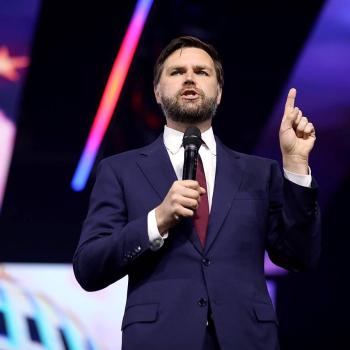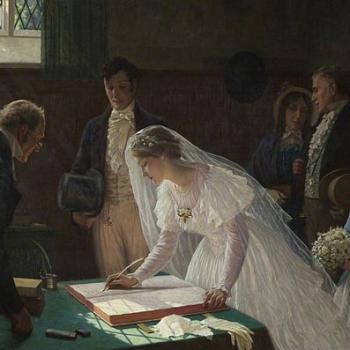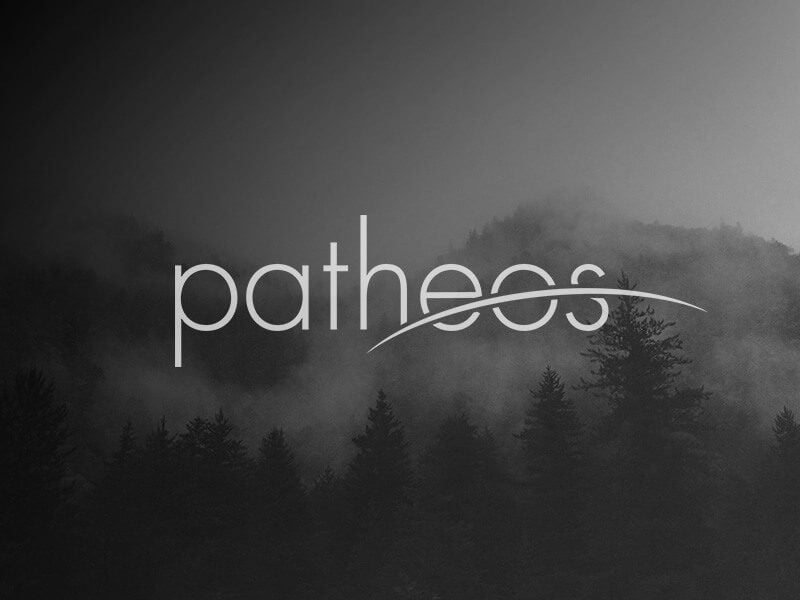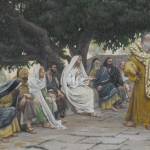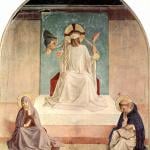He knew he was going to meet Jane, and something was beginning to happen to him which ought to have happened to him far earlier. That same laboratory outlook upon love which had forestalled in Jane the humility of a wife, had equally forestalled in him, during what passed for courtship, the humility of a lover. Or if there had ever arisen in him at some wiser moment the sense of ‘Beauty too rich for use, for earth too dear,’ he had put it away from him. False theories, at once prosaic and fanciful, had made it seem to him a mood frousty, unrealistic, and outmoded. Now, belated, after all favours had been conceded, the unexpected misgiving was coming over him. He tried to shake it off. They were married, weren’t they? And they were sensible, modern people? What could be more natural, more ordinary?
C.S. Lewis. That Hideous Strength (New York: Scribner Classics, 1996), 378.
Much of the discussion on the nature of marriage and divorce from Lewis and Tolkien involved two different concerns. The first is on the nature of marriage itself. Lewis certainly held to the fact that there is a sacred element bestowed upon the institution when practiced within a Christian setting. Yet, he also thought that it is primarily a natural institution, and only secondarily a religious institution given grace by God. In this way, it must be first addressed as a secular institution, free from the religious significance, and society is free to discern what it is and what it is not, and to regulate it according to how it sees fit. The strength and validity of such a marriage is in its vows; this is also its weakness. A couple should be sincere when they makes those vows, otherwise it would be better for them not to be married. On the other hand, something can happen while the couple is married which means the vows can be broken (for example, one of them becomes quite abusive). Society, because it is looking after the needs of the people involved, is free to dissolve such marriages. This leads us to Lewis’ second concern, and that is, the relationship between secular forms of marriage with Christian marriage. Since marriage is a natural activity, predating the Christian faith, Christianity does not have an exclusive right to define what it is or is not for the rest of the world. However, Christians can and must define what it is within the domain of the Christian faith. Their views should be heard by the state, but the state is under no obligation to define marriage in the say way Christians do.
Tolkien, as we have seen, would have none of this; marriage is a moral issue. If Christians believe that a certain moral condition must be met for marriage to be acceptable, and those conditions help regulate marriage and prevent it from being abusive, then Christians can not stand by and accept society turning away from those norms, especially if a given society once followed them.
Charles Williams looked at the matter in a different light. While understanding the questions involved with marriage and divorce, and the changing situation of society, he thought the best way to address the issue is to look at marriage within the romantic tradition, and to look at it under the lens of love. Marriage must be seen as the union between two lovers aided by the active participation of God in their relationship. God can and does work in the lovers, and can unite them with or without the institution of marriage: Dante wasn’t married to Beatrice, but it was his love for her which paved the way to paradise.[1] But he saw that marriage must be the primary exemplar of romantic theology. Because it allows for sexual union, eros, the relationship between a married couple allows for a kind of unity which other, a-sexual forms of love cannot possess. Yet this does not deny the possibility that some of the other forms of love can, for a given person, be greater than what they experience with eros. Charles Williams, devoted as he was to his Romantic Theology, admitted that his notions were new, and should be tried and considered by the Church, to discern what, if anything, in it is good and true.[2]
If we pay careful attention to the discussion, we can see that both Lewis and Tolkien are looking at it within the domains of a two-tiered system of nature-supernature, that is, both are following the dictates of a “theology of pure nature,” with all complications such a theological view brings.[3] Indeed, such a theological position causes all kinds of difficulties in trying to understand the relationship of natural, secular virtue with what is expected by a person from a religious standpoint; and it is these difficulties which both Lewis and Tolkien are trying, in their own way, to overcome.[4]
C.S. Lewis was correct in assuming that humanity has a right, and need, to construct a social order. The problem is in assuming that order is an end in itself, and that it can be a closed, purely natural system. It must always be open to God, both in the order of judgment and in the order of grace. When social structures are sinful, or become sinful, they must be judged and condemned; no matter how many people want to defend it, it cannot be supported. In this way, Tolkien is correct in his disagreement with Lewis: when a given social structure leads to abuse, it must be denied.
Different societies can have different ways in which they order themselves. An institution like marriage can be practiced in various ways. In saying this we must also say that not that all possible forms of marriage are acceptable. What is established in society must be open to grace, and if it is, then it can become a vessel by which God acts in and among humanity. But again, we must make it clear, in providing a solution which is both flexible and open, it is easy to find one social structure, and assume it is the only possible structure in which such good can come about. Or if not, that it is still the best way in which God and humanity can work together. Neither needs to be true for a particular system to be acceptable (thus, at times, polygamy can be acceptable, as Christian Scripture shows; in the New Testament, all discussion of marriage is between one man and one woman, because it better exemplifies the relation between Christ and the Church; in this way, monogamy is the better way). We must recognize the relative value of “natural structures.” They help keep society running. But they must never be seen as more than that.
This is what makes Charles Williams stand out; he was trying to take a different path to understand the relationship between the secular and sacred spheres of existence: the path of love mysticism. It is a path which he didn’t create, but clearly one which has been ignored in modern times. And it’s one which, because of such neglect, has failed to produce more than a shallow explanation for the concerns which face us today. But Charles Williams reminds us of this path as he was adding his own intuitions to it. The lover, because they love, experiences God in the midst of that love. The lover, in their love, is never separate from God, and so the order between nature and supernature, by that act of love, is already overcome; the two realms of existence are seen to interpenetrate one another. The way is best displayed in the poets, and they have shown us how love can allow two to merge as one, even as they remain two. But, in saying this, we must remind ourselves as to what Charles Williams admitted: his theology was only initiating reforms. He was doing so when the dualism of pure-nature theology, in its many forms, prevailed; it was therefore, at that time, difficult for others, even his friends, to see what it was he was pointing out. Only after the dualism of the “pure nature” theology had been undermined could the way of the poet return and be embraced.
This kind of advance is what we see taking place in theology after Henri de Lubac. There is perhaps no greater example of the way of the poet being united with theology than in the work of Hans Urs von Balthasar.[5] In addressing the issues raised by Lewis and Tolkien, he was able to cuts through the chase and explain how the new understanding of the relationship between nature and grace can be reflected in the order of marriage. Although it is a “natural institution,” it is also a supernatural institution; indeed because it has a supernatural basis it can be natural. “What is natural in marriage has a supernatural origin and, therefore, also a supernatural purpose.“[6]Karl Rahner agrees. “Because of the sign character of married love and because of what it points to, marriage is never merely ‘a secular thing.’ For it is an event of the grace and the love which unites God and man.“[7]
How are we to understand this insight with the history of the institution of marriage? Can we see all forms of marriage (if they are legitimate) as being in Christ? Yes. Even before the incarnation, the effects of the death and resurrection of Jesus have influenced human history. All of history has it for its basis, as its center, and it draws all of temporal events towards itself. This is because it is the eschatological event. Having happened in a particular time and place, it also takes place in eternity, and therefore, it is a transcendent event, able to grant elements of grace to those who lived before the event in anticipation of its accomplishment (such, of course, is how we understand the grace given to the Theotokos at her conception, and St John the Baptist while in the womb of St Elizabeth). There is no point in human history where humanity has not held some connection to the cross (even the creation of the world is tied to the crucifixion). The historical foundation for marriage, wherever it is found, must be seen as connected to the cross, and therefore, is never purely natural and of its own. But, before the cross, marriage can only imperfectly do what it sets out to do; its fullness can only be found when it is elevated to the level of a sacrament, and this can only happen, in time, after the resurrection.
Thus, from the beginning of time, from “Adam and Eve,” the love manifested between two lovers has always pointed to the cross, and therefore, to the relationship between Christ and the Church.[8] Our rejection of divorce should be understood in this light. “Indissoluble marriage is in fact only comprehensible and feasible on the basis of faith in God’s henceforward irrevocable decision, embodied in Christ, in favour of ‘marriage’ with mankind.“[9] Marriage has shown us our need to be with someone else, not to be alone. No one is meant to be an island unto themselves. “For the man/woman relationship can stand as a paradigm of that community dimension which characterizes man’s entire nature.“[10] It shows the openness of human nature, of the human person; to receive another in our life is to admit we cannot do all things by ourselves. Divorce is an attempt to close oneself off, to become an individual after already being a part of a family community. Or, as Charles Williams tells us, we try to close ourselves to the gift of God given to us in our marriage. This is not to say that those who are celibates cannot experience love, cannot find their own way of experiencing the grace involved with such love. Indeed, as Adrienne von Speyr pointed out, there is a way in which we can discuss virginal love so that it too demonstrates something about our relationship with God.[11]
This can bring us back to the great divide between C.S. Lewis and J.R.R. Tolkien. Both of them try to reflect upon marriage within a natural order. C.S. Lewis is right in saying that we must be given freedom to experiment and create a variety of social structures, but then we should see if they can be affirmed by God. None of them exist by themselves, outside of some relationship to the supernatural, though sometimes that relationship is about closing itself off to the supernatural. And in this way J.R.R. Tolkien is right: not all experiments will end in success; not all that we can create for ourselves will end up being valid. There is no one “natural” way to be human, and certainly no purely natural institution of marriage. Any suggested form of marriage is either open to or closed to the graces of Christ (of course, these graces might be hidden and unknown to the couple). Those which can be discerned as being open are permissible, those which are closed are not. In this way, we can find a way to meld the insights of Lewis and Tolkien; we must admit to some flexibility to the institution as it is found in the world, but it must never be so flexible that something is defined as marriage which has no commonality to what has been practiced in the past. Overcoming the great divorce between nature and supernature continues to be the project theology now addresses. The influence of the old way of thought is still all around us, influencing the way we look at the problems before us. That, of course, is the issue; but now that we know that we must reshape our way of thought, we can now look at the problems in this new light, and hopefully, after much work, find better answers to our societal problems, leading us to a better world, even if perfection will only be had in the eschaton.
Footnotes
[1] Charles Williams. The Figure of Beatrice (London: Faber and Faber, 1953), 191.
[2] See Charles Williams. Outlines of Romantic Theology(Berkley, CA: The Apocryphile Press, 2005), 72-3.
[3]This break between nature and supernature is clear in Lewis. For Tolkien, it might not be immediately clear, but if we look carefully at the extreme difference he sees between what is natural for man and what is required for man by Christ, we can discern its influence. The natural world is understood within its own terms alone, with it being barely touched (at best) by the supernatural. We can even discern this in The Lord of the Rings, where we find a natural, earthly paradise represented not only by the Shire, but the ancient world as a whole. The so-called natural, pagan ethic is emphasized as being capable for the most part of handling its own affairs. Only because of a greater, unnatural, danger (Sauron), can it not succeed without some external, secondary aid (the Maiar). Even during this time, the direct influence of Eru upon the earth is difficult to discern. Once he set the world in motion, he left it to itself. This is not to say there is no element of grace in Tolkien’s world (there is a great deal of it, but it is used to heal the world from the harm done by supernatural evil). Nonetheless, there is one important instance where Tolkien is either on the verge of transcending the pure nature divide, or does so, and it is with his understanding of man as subcreator, especially as found in the poem Mythopoeia.
[4]It must be admitted that when theology overcomes the nature/super-nature divide, it does so following the example of Christology. Rejecting a dualistic, Nestorian like approach must not lead us to the other, monistic, Monophysitical extreme. The two, nature and supernature, work together and are united as one, because they are open to one another, and there is no artificial barrier between them. Nonetheless, we must also remember they do not disappear in the process.
[5]Of course, engaging theology through the poets makes it possible for Balthasar to be misunderstood. This is especially true because, at times, like the poets before him, he can state things in a rather shocking fashion (such as happens in his book, Heart of the World).
[6]Hans Urs von Balthasar. The Christian State of Life. Trans. Sister Mary Frances McCarthy (San Francisco: Ignatius Press, 1983), 229.
[7]Karl Rahner. Foundations of Christian Faith. trans. William V. Dych (New York: Crossroad Book, 1978), 419.
[8] “One can say that it is thereby evidenced that God from the beginning in the garden of Eden created marriage to be such an image of the relation between Christ and the Church,” Karl Rahner. The Church and the Sacraments. trans. W.J. O’Hara (London: Burnes & Oates, 1964), 107-8.
[9]Joseph Ratzinger. Introduction to Christianity. trans. J.R. Foster (New York: Crossroad Books, 1979), 201.
[10]Hans Urs von Balthasar. Theo-Drama II. Dramatis Personae: Man in God. trans. Graham Harrison (San Francisco: Ignatius Press, 1990), 365.
[11] “The married state emphasizes the love between two human persons. The state of virginity (which now includes the evangelical and priestly states) emphasizes above all man’s love for God. Through his love for another person, man finds in marriage new access to God; through his love for God, the celibate person finds a new access to mankind. In one sense, then, married love more strongly indicates divine love as it is revealed in the Persons of the Trinity, whereas virginal love more strongly indicates the same love as it is revealed in the nature of God,” Adrienne von Speyr. The Christian State of Life. trans. Sister Mary Frances McCarth (San Francisco: Ignatius Press, 1986), 74.




